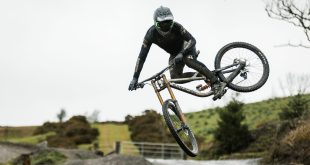Abus was founded over 80 years ago. Working in the home security market the firm has expanded its security offering to cover everything from window security to keeping things safe on the move, including motorbikes, scooters, boats and – of course – bicycles. Its extensive offering has even seen it supply Wembley Stadium with security products, trivia fans.
Back when it was set up in the 1920s, Abus was one of 40 producers of locks in the same area of Northern Germany, of which now only three survive (including Abus). While finding a manufacturer operating in Europe is an increasingly rare phenomenon, Abus’ countryside factory setting is, to the unfamiliar, equally unlikely.
BikeBiz visited the German production facility and HQ to see first-hand how Abus puts together its product range.
The company is, according to Abus, the world’s biggest padlock manufacturer. It recently made history when it won a contract with the US Army, the first time a non-US based company had achieved that feat.
Our guides for the day – Abus’ area sales and marketing manager Axel Rosler and international marketing and PR manager Mark Stuiver – tell BikeBiz that the company has succeeded because it has concentrated on who its customer is and never lost sight of that. In the case of Abus, that customer base is firmly in the family, commuter and child market.
That market has taken to the likes of Abus’ foldable Bordo lock range, which has, Rosler tells BikeBiz, gone from strength-to-strength. Recent highlights also include the lightweight Mini U lock for fixies and singlespeed markets, an area that is still booming worldwide, the firm says.
That growing market has led to the firm extending its sites in Germany. Abus also has a facility in Asia, which it owns, and employs around 800 staff there. The firm has around 1,400 employees in Germany. Looking after staff is a focus for the ‘Christian corporate structure’, where suggestions for improving workstations are rewarded and holding on to skilled staff means it has begun to offer workers the chance to work from home, rather than lose those who have to look after their families. They also have a soccer playground, mini golf and table football facilities, which helps too.
In production
So what goes into the production of Abus’ ranges? Naturally enough it all starts with design. Using Computer Aided Design (CAD), Abus’ engineers and designers start with a virtual cube and whittle it down to the product in question. It’s at this stage that the design of the products are honed, with pre-testing simulated on computers before any physical product is created, which handily keeps costs down. A 2D blueprint is automatically updated as the designer supplies the finishing touches, which is then used in the physical creation of the product.
The pernickery design process takes into account all manner of considerations, including mould flow, pinpointing where the injection point should be made to bolster the integrity of the product. Physical testing is also a vital part of the process, but more of that later.
When the product goes into production a key consideration is hardening. Raw materials musn’t be over-hardened and brittle, for obvious reasons. The secret is, Abus say, to treat the raw material correctly. Repeated, controlled temperature changes – from subjecting the material to high temperatures, then cooled with liquid, then subjected to higher temperatures before being cooled again – toughens the material.
During this process, and throughout production, dimensions are always tested to ensure each product has no distortion. Test tools created in-house are used at different stages of production all with the aim, in the words of the firm, ‘so our products last for years and years’.
Machines (also created by Abus) bend, punch holes in and generally shape the materials, while teams of personnel shape put the pieces together. Japanese-style product islands are increasingly used at the firm for a ‘one-piece flow system’. Up to six people can work in the flexible islands, while staff aren’t stuck endlessly completing the same repetitious work. After completion the products are shifted off the Abus’ nearby warehouse for distribution around the world.
Not to understate it too much, but the lock part of the production process is pretty important. Abus uses techniques and computer generated combinations (around 2.5 million) for combination locks and key locks. ‘Unreal numbers’ – like 111112, 111113, etc – are deleted automatically, while there are around 1.5 million key combinations, all logged and reproducible for spares by the factory. It’s proper locksmithery stuff, Abus tells BikeBiz.
Testing, testing
But before those products go out into the wide world, there is testing on an industry scale to be done. Corrosion testing is one aspect, where products are placed into a salty steam bath, aggressively subjecting products to the equivalent of long term real world conditions. It’s essential stuff when one of your products (for the boat market) is designed to be submerged in sea water during its working life.
Other machines in the product torture chamber, if you will, include the cold cutting machine that saws into the metal without affecting the temperature of the material, so it can be tested correctly. As touched on earlier, dimension testing is a key part of the process too. Abus uses a vibration-free room, complete with a sprung floor, where computer tech, lasers and high definition cameras ensure the product is dimensionally accurate.
Even impact testing and tests of how a lock copes with a key inserted into it many many times are carried out.
Products that have made it this far have still got to jump through the hoops. A selection of products are taken from each batch and then subjected to freezing, sawing, stretching and twisting to see how they hold up under the kind of force nefarious types will subject them to when they’re trying to steal bikes.
This final testing area has another aspect – it was here that it was discovered that a parabolic shaped U-lock was found to be harder to car jack than a standard u lock. Innovations discovered through testing, have been filtered into the product range.
Once again, machines are used in testing to ensure they’re fair. Having an employee wielding a sledgehammer to test a lock may seem like a stern test, but it is dependent on the employee (and how much they had for lunch), while a machine provides almost perfectly reproducible tests, BikeBiz learns.
There are brutal ways (wire cutters, saws) and intelligent ways (lock pickers, etc) to hack locks, with brutal predictably the most popular. Both are used in this ‘worst case scenario’ testing arena. Locks are subjected to tonnes of pulling pressure, deep freezing (with Canada an important market for Abus, how locks perform in serious chills is an important focus), twisting (to simulate crowbar attack) and more. Naturally BikeBiz saw Abus products standing up to incredibly rigorous testing during the factory visit, not least from our own fair hand, and experienced frustration when attacking the products with huge cutting implements.
In fact, frustration is exactly what the firm is hoping for. “We want the thief to get frustrated and give up trying to saw or cut the locks,” Rosler says.
 BikeBiz Bicycle and cycling retail news
BikeBiz Bicycle and cycling retail news



